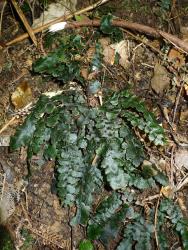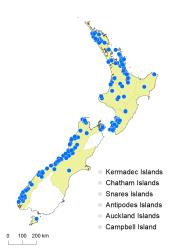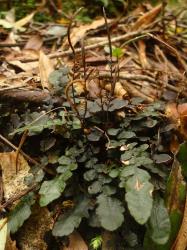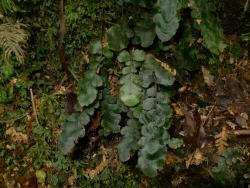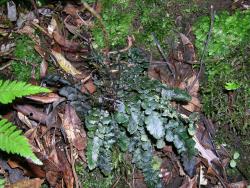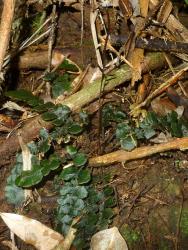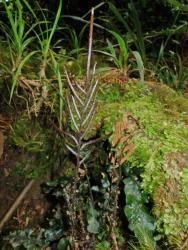- ≡ Lomaria nigra Colenso, Tasmanian J. Nat. Sci. 1: 375 (1843)
- ≡ Spicanta nigra (Colenso) Kuntze, Revis. Gen. Pl. 2, 822 (1891)
- ≡ Struthiopteris nigra (Colenso) Ching, Sunyatsenia 5: 243 (1940)
- ≡ Cranfillia nigra (Colenso) Gasper & V.A.O.Dittrich in Gasper et al., Phytotaxa 275: 208 (2016)
- = Polybotrya nana Fée, Mém. Foug., 2. Hist. Acrostich. 75, t. 38, f. 1 (1845)
Rhizomes erect, up to 50 mm long (in herbarium material), bearing scales. Rhizome scales narrowly ovate, 3–5 mm long, 0.6–1 mm wide, chestnut-brown, concolorous. Fronds strongly dimorphic; sterile fronds 50–275 mm long, forming a prostrate rosette; fertile fronds on same plant equalling or longer than the sterile fronds, 60–310 mm long, positioned centrally, held erect. Sterile fronds. Stipes 10–90 mm long, red-brown, bearing abundant scales similar to those on the rhizome, and straight red-brown hairs up to 0.5 mm long. Rachises red-brown or yellow-brown, grooved adaxially, bearing dense red-brown hairs and occasional scales. Laminae 40–195 mm long, 12–50 mm wide, pinnatisect, lyre-shaped, the terminal pinna the largest, the lateral pinnae decreasing in size to the base of the lamina, but the basal pair enlarged and equalling or exceeding the pair above, very dark green on both surfaces, herbaceous to coriaceous, bearing red-brown hairs on the abaxial surfaces and margins. Pinnae in 2–14 pairs below pinnatifid apex, widely spaced, oblong, straight; the longest pinnae at or above the middle (or sometimes the basal pair), 5–30 mm long, 5–20 mm wide, apices obtuse to rounded, margins irregularly dentate, bases adnate; the basal pinnae opposite, often with enlarged basiscopic auricles. Veins free. Fertile fronds. Stipes 25–150 mm long. Laminae 30–180 mm long, 8–50 mm wide, scaly and hairy. Pinnae in 1–10 fertile pairs, linear, straight, 6–45 mm long, 1–2 mm wide, reducing to much shorter sterile segments at the lamina base. Sori and indusia in one row either side of costa, continuous along the length of the pinna.
Blechnum nigrum is a very distinctive species recognised by its strongly dimorphic fronds, free veins, pinnatisect sterile laminae, and continuous sori. It has dark green fronds and sterile laminae with an enlarged terminal pinna. The lateral pinnae decrease in size down the frond except for the enlarged basal pair, which are often as wide as the terminal pinna. The stipes, rachises, abaxial surfaces of the laminae, and margins of the pinnae are covered in short, stiff, red-brown hairs. The pinnae are adnate to the rachis, irregularly dentate on their margins, and rounded at the apices. The fertile fronds are the same size as, or slightly longer than, the sterile fronds. The species grows prostrate in dark, wet forest habitats and is often covered in epiphyllous bryophytes.
North Island: Northland, Auckland, Volcanic Plateau, Gisborne, Taranaki, Southern North Island.
South Island: Western Nelson, Sounds-Nelson, Westland, Canterbury, Fiordland.
Stewart Island.
Altitudinal range: 15–960 m.
Blechnum nigrum occurs in lowland to montane areas of the North Island from Kaitāia to Wellington, but it is more common on the western side. It grows from 120 m, reaching 960 m near Matawai, Gisborne. In the South Island it is largely confined to the western side of the main divide, extending from the Marlborough Sounds to Fiordland and Stewart Island, with an outlying population in Peel Forest. It has been observed in Southland (see iNaturalist 8514443), but not yet collected from there, and hence not recorded on the distribution map. It grows from near sea level, up to 760 m in the Mt Wynyard Range, Canterbury.
Blechnum nigrum is a terrestrial fern found in podocarp, broadleaved and beech forest. It grows on stream banks, in gullies, on damp rock faces and banks, between boulders, under tree roots, and on the ground in dark, wet forest.
2n = 66 (Chambers 1954).



